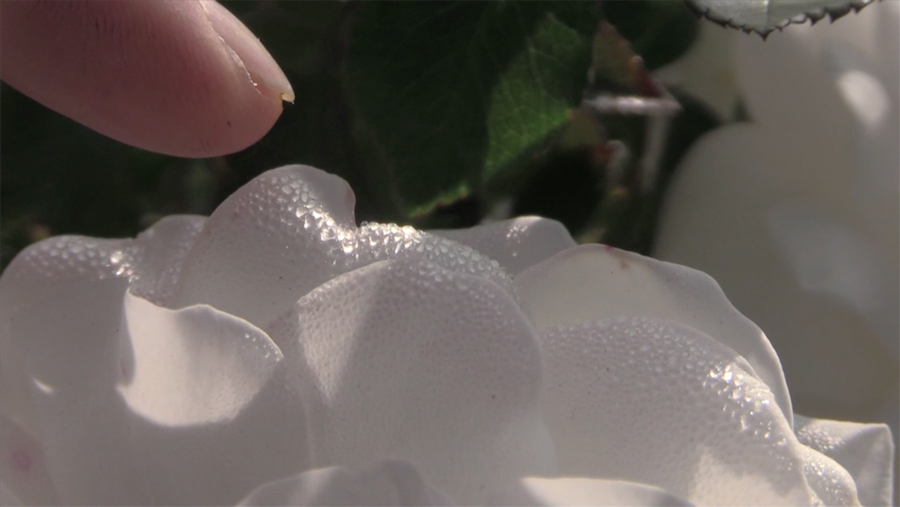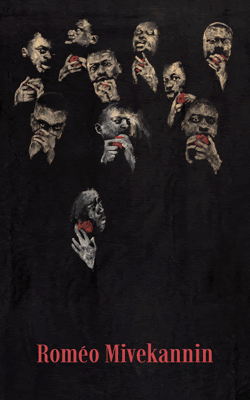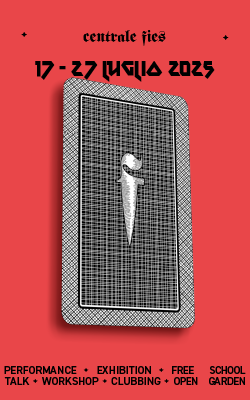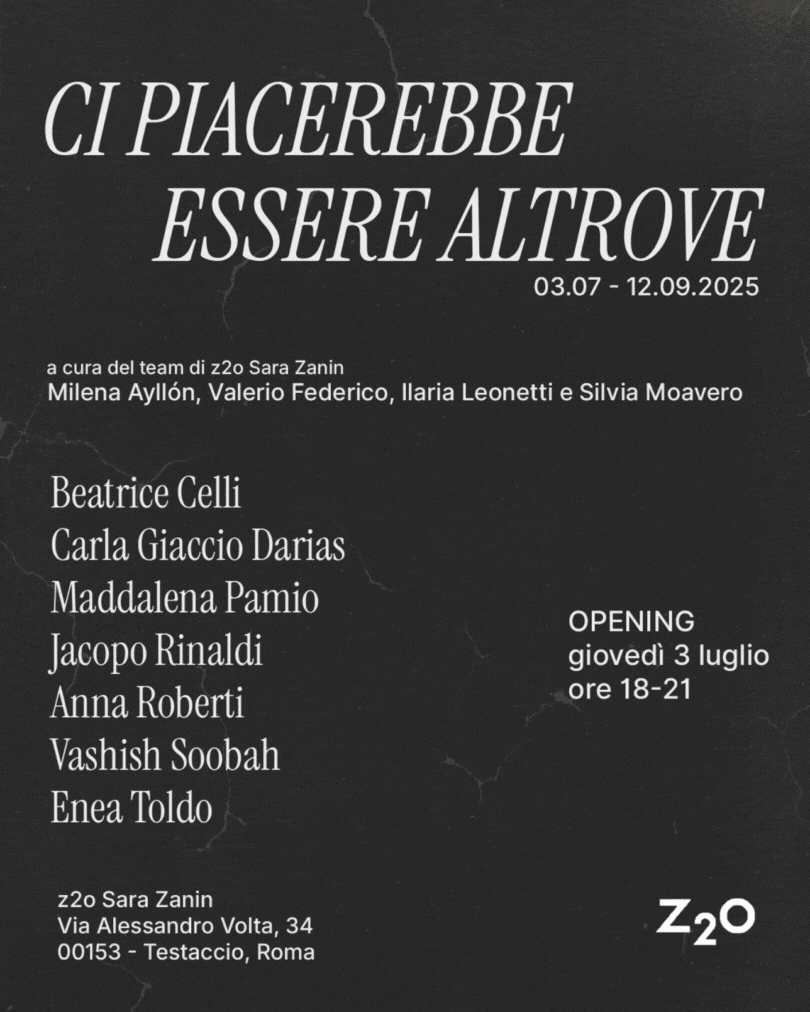[nemus_slider id=”66712″]
—
English text below
Fino al 21 luglio, lo SpazioA di Pistoa ospita una collettiva – a cura di Martha Kirszenbaum – con gli artisti: Dora Budor, Margaret Honda, Matthew Lutz-Kinoy, Laure Prouvost e Reza Shafahi
Waiting for the Sun riunisce cinque artisti le cui opere ripensano il nostro rapporto con la finzione e le narrative cinematografiche. Distorcendo le nostre percezioni e aspettative di spettatore, lettore, o corpo che opera nello spazio, i lavori in mostra manipolano fatti e fantasia, realtà e rappresentazione di oggetti, luci e situazioni sociali.
Unendo rappresentazione del desiderio, onirismo e una descrizione romanzata della natura, i film, le installazioni, i disegni e gli arazzi di Laure Prouvost (nata nel 1978 a Lille, Francia, vive e lavora a Londra e Anversa) mettono in discussione il nostro rapporto con il linguaggio e la comprensione costruendo narrative complesse e momenti surrealisti che alimentano l’insolito approccio dell’artista alle convenzioni del film e dell’immagine. La mostra presenta due video proiettati come un dittico visivo, contenenti immagini contrapposte e tremolanti di natura e tecnologia, di paesaggi urbani e rurali. Prouvost ha immaginato due storie di adolescenti filmate nella campagna francese e in un parcheggio di Downtown Los Angeles. All’età dei loro primi flirt, sognano fughe e libertà. Questo paesaggio di adolescenza fa da sfondo a una narrazione fatta di frammenti di testo, brandelli di immagini e sottotitoli imprevedibili, dando vita a fantasie corrotte grazie al senso dell’umorismo e a traduzioni sbagliate. In modo simile, in uno scontro urbano tra vita botanica e costruzione umana, Matthew Lutz-Kinoy (nato nel 1984 a New York, USA, vive e lavora a Los Angeles) che oscilla tra pittura e poesia, performance teatrale e ceramica, si concentra sul corpo e sul modo in cui plasma lo spazio che abita. La sua installazione è composta da due tele che, come una cornice sica, ci guidano all’interno della stanza. Il dittico rappresenta l’interesse per lo spazio scolpito e la durata, visti attraverso le lenti di un positivo/negativo filmico: da una parte un dipinto floreale liquido con una stampa serigrafica sul retro che replica una fotografia di Zoe Leonard. Sulla parete opposta la stessa serigrafia che compare sul lato visibile di un’altra tela. Questa dualità mostra uno spazio di moltiplicazione o trasparenza; il negativo come indice, la visione di un’opera attraverso il suo retro per rivelare un’immagine più completa.
Le istallazioni di Dora Budor (nata nel 1984 a Zagabria, Croazia, vive e lavora a New York) esprimono la sua fascinazione per l’atto di decostruire le convenzioni e i ricordi delle narrative e delle tecniche del cinema, la sua scenografia e la poesia, la distanza e il desiderio, reinvestendole in situazioni fisiologiche. Attratta da eventi apocalittici e ispirata dal 1816, noto anche come “l’anno senza estate”, in cui le anomalie climatiche avevano portato a un rigido inverno vulcanico, Budor ha realizzato un diffusore di ceneri finte che soffia polvere grigia nella galleria e reagisce continuamente alla nostra presenza e fisicità. L’artista ha disposto nel centro dello spazio il divano bianco modulare Superonda, progettato dal gruppo di architetti toscani Archizoom Associati nel 1966, enfatizzando sul momentum cinematografico e sulle narrative utopiche radicali. In modo simile Margaret Honda (nata nel 1961 a San Diego, vive e lavora a Los Angeles) confonde i confini tra processo e risultato, tra la storicità degli oggetti e la loro autonomia di tempo e spazio. Lavorando con una serie completa di gel da illuminazione Rosco CalColor, solitamente usati nella produzione cinematografica, Honda copre tutte le finestre dello spazio con una progressione di 66 fotogrammi di dimensioni uguali, ordinati secondo il sistema di numerazione Rosco. I vari colori e le saturazioni dei gel alterano delicatamente la visione del mondo esterno e al contempo trasformano la naturale luce dorata della Toscana all’interno dello spazio espositivo.
Infine, nelle sue inquietanti e misteriose opere su carta, fatte a matita e pennarello Reza Shafahi (nato nel 1940 a Saveh, Iran, vive e lavora a Tehran) oscilla tra un immaginario sviluppato nella tradizionale miniatura persiana o ispirato dalle poesie di Omar Khayyam or Hafez, e una tavolozza moderna di colori e forme che evocano Henri Matisse. Alcuni dei disegni esprimono oscure fantasie erotiche, altri hanno una venatura di surrealismo o ricordano scene cinematografiche.

Waiting for the Sun
curated by Martha Kirszenbaum
Dora Budor, Margaret Honda, Matthew Lutz-Kinoy, Laure Prouvost and Reza Shafahi
SpazioA, Pistoia
Until 21.07.2017
Waiting for the Sun brings together five artists whose practices rethink our relationship to fiction and cinematic narratives. Distorting our perceptions and expectations as a viewer, a reader or a body performing in space, the works in the exhibition manipulate fact and fantasy, reality and representation of objects, light, and social situations.
Combining depiction of desire, oneirism, and a fantasized description of nature, Laure Prouvost’s (b. 1978 in Lille, France, lives and works in London and Antwerp) films, installations, drawings and tapestries imperil our relation to language and comprehension through the construction of complex narratives and surrealist moments that feed her unusual approach to the conventions of film and the image. The exhibition presents two videos projected as a visual diptych and composed of similar twitchy images opposing nature and technology, rural and urban spaces. Prouvost has imagined two stories of teenagers filmed in the French countryside and in a parking lot of Downtown Los Angeles. At the age of their first flirts, they dream of freedom and escapism. This landscape of adolescence conveys a narrative made of fragments of texts, scraps of images and unpredictable subtitles, bringing corrupt reveries to life through humor and mistranslations. Similarly, in an urban crash between a botanic life and human construction, Matthew Lutz-Kinoy’s (b. 1984 in New York City, USA, lives and works in Los Angeles) multifaceted practice, swaying from painting to poetry, theater performance to ceramics, concentrates on our bodies and the way they shape the space they inhabit. His installation comprises two canvases acting as a physical frame guiding us inside the room. This diptych exposes an interest in sculpted space and duration seen through the lens of a filmic positive / negative: on the one hand a liquid floral painting with its reverse side composed of a silk-screen replicating a Zoe Leonard photograph, and on the opposing wall, the same silk-screen appears on the visible side of another canvas. This duality shows a space of doubling or transparency; the negative as index, seeing through the work to its reverse side to reveal a more comprehensive image.
Dora Budor’s (b. 1984 in Zagreb, Croatia, lives and works in New York) installations articulate a fascination for deconstructing the conventions and memories of cinema’s narratives and techniques, its props and poetry, its distance and desire, reinvesting them into physiological situations. Fascinated with apocalyptic manifestations and inspired by the year 1816, also called “the year with no summer” that saw climatic abnormalities provoke a severe volcanic winter, Budor has conceived a diffuser of fake ash, blowing gray powder in the gallery and continuously reacting to our human presence and physicality. In the center of the space, the artist has disposed a white modular sofa Superonda, designed by the Tuscan architects group Archizoom Associati in 1966 and emphasizing on cinematic momentum and radical utopian narratives. In a comparable way, Margaret Honda (b. 1961 in San Diego, lives and works in Los Angeles) blurs the lines between the process and the result, the historicity of the objects and their autonomy in time and space. Working with a complete set of Rosco CalColor lighting gels, normally used in film production, Honda covers all the windows in the project space with a progression of 66 equal-sized frames, ordered according to Rosco’s numbering system. The gels’ different colors and saturations subtly alter the view of the outside world while also transforming the naturally golden Tuscan light inside the exhibition space.
Finally, in his uncanny and haunting works on paper made with pencil and marker, Reza Shafahi (b. 1940 in Saveh, Iran, lives and works in Tehran) oscillates between an imagery echoing traditional Persian miniature or suggesting tropes developed in the poetry of Omar Khayyam or Hafez, and a modern palette of bright colors and dancing shapes evoking this of Henri Matisse. Some of his drawings express dark erotic fantasies while others are tainted with surrealism and recall cinematic scenes.












